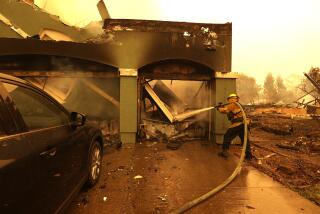$4.4-Billion Loss by Ailing S&Ls; Puts Industry in Red
- Share via
WASHINGTON — The financially ailing segment of the savings and loan industry suffered massive losses of $4.4 billion during the first quarter of the year, dragging the entire industry into the red, the Federal Home Loan Bank Board reported Tuesday.
The red ink of the troubled institutions was up from $3.7 billion the previous quarter, and immediately increased pressure on the bank board to begin cracking down by closing or merging more of the S&Ls.;
Only 344 of the 3,118 federally insured S&Ls; were insolvent during the first three months of the year, but their losses overwhelmed the modest $600 million in profits earned by the others. The result was a net loss of $3.8 billion for the industry.
It is clear “the corner still hasn’t been turned in the industry’s crisis,” said Rep. Fernand J. St Germain (D-R.I.), chairman of the House Banking, Finance and Urban Affairs Committee. “ . . . It is time that the bank board comes to grip with the future and proposes hard-nosed solutions that will last more than a few months.”
The bank board has been reluctant to intervene aggressively against struggling institutions because of fear that its federal insurance fund will be depleted through liquidations. It also has hoped that the economy in some of the worst trouble spots would improve enough to allow ailing institutions to recover.
In response to a question at a news conference in Toronto, where he was attending the economic summit meeting, President Reagan said: “I don’t believe there is a crisis. There is a problem, and we are trying to deal with the problem.”
However, Tuesday’s report showed steady deterioration. Texas, whose economy has been battered by slumping oil prices and real estate values, accounted for the largest share of the deficit. The 117 insolvent thrifts there generated a whopping $3.3 billion in losses during the quarter, most of it concentrated in 20 institutions.
Many of those S&Ls; have portfolios of loans on shopping centers, apartment buildings, homes and office complexes on which payments have ceased or declined and whose real estate value is plummeting.
“We have two separate and distinct types of thrifts in this country, the seriously troubled . . . as well as the solvent segment,” James Barth, the bank board’s chief economist, told a news conference. The losses of the former are getting “quite a bit bigger,” he said.
Accounts Insured
Despite the crisis for regulators and S&L; managers, there is no threat to the safety of accounts up to $100,000, which are covered by federal deposit insurance. “Insured depositors have nothing to be concerned about,” Barth said.
There are widespread concerns in Congress and among financial experts that the cost of curing the industry’s ills could exceed the assets available to the bank board. Its insurance fund, subsidized through fees by member institutions, has less than $2 billion and it has access to $10.8 billion in special notes authorized by Congress. Further funds to cover insured deposits would have to come from the federal Treasury, potentially worsening the huge federal budget deficit.
The bank board has estimated that it would cost $22 billion to close out the crippled institutions, but the General Accounting Office has said that the expense could reach $36 billion. Some industry consultants have projected the actual cost as much higher.
Strategy for Texas
At a House Banking Committee hearing next month, committee members will question bank board Chairman M. Danny Wall about the cost estimates and about the strategy for combining and disposing of thrifts in Texas.
In Tuesday’s report, it was clear that troubles in Texas “dominate the overall picture of the industry,” Barth said.
Richard L. Peterson, professor of finance at Texas Tech University in Lubbock, described the state’s real estate market as “very weak. There is a high vacancy rate and it takes a while to absorb” the surplus of empty offices and apartments in Dallas and Ft. Worth. And “Houston has been overbuilt for a long time,” he added.
Many struggling S&Ls; are reluctant to acknowledge the deterioration of their investments. “As long as you can keep a loan at book value rather than market value, it does not show up as a loss,” Peterson noted. But with new, tougher rules imposed by the bank board, S&Ls; are being forced to list the true value of many real estate loans and the slim chances they will be repaid. This requires writing down the value of the asset.
Fear Further Harm
Still, the regulators have been wary of acting precipitously against the institutions, fearing that if they liquidate loan portfolios and dump more real estate on the depressed market, it will lower values more and further harm the economy and the condition of other S&Ls.;
But St Germain said that the rising losses may require a tougher stand. There are “extremely serious questions about the rosy scenarios being peddled by the bank board,” he said. “ . . . The industry can and will recover, but the regulators need to do more than quickie, half-baked assistance packages coupled with ‘soft-ice-cream,’ all’s-well statements.”
In sharp contrast with Texas, the California thrift industry is in sound financial condition, Tuesday’s report showed. The San Francisco Federal Home Loan Bank district listed 190 solvent institutions with profits of $270 million during the quarter. There were just 29 insolvent firms with losses of $245.4 million during the quarter.
Costa Mesa Firms
Much of the California losses came from a pair of Costa Mesa institutions, American Diversified Savings Bank and North America Savings & Loan, which were closed earlier this month with $1.35 billion returned to depositors.
In California and other areas, the bank board “basically has its arms around the problem” of troubled thrifts, said Brian Smith, senior vice president for regulatory affairs with the U.S. League of Savings Assns., an industry trade organization.
But the solvent thrifts are becoming impatient about the losses by the others, he said. A special assessment, one-eighth of 1% of deposits, cost the profitable portion of the industry $250 million in the quarter.
“From California to New England, folks are saying, ‘This is a significant burden on my healthy institution,’ ” he said.
More to Read
Inside the business of entertainment
The Wide Shot brings you news, analysis and insights on everything from streaming wars to production — and what it all means for the future.
You may occasionally receive promotional content from the Los Angeles Times.










